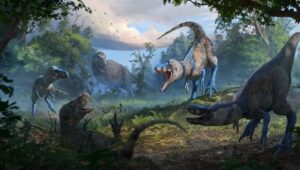While some of us are still recovering from the giant bugs of Peter Jackson’s King Kong, it turns out the “biggest insect” title actually goes to a dragonfly.
(Cue the giant sigh of relief.)
Dwarfing modern insects, a massive dragonfly from the late Permian era named Meganeuropsis permiana holds the record as the largest insect ever to have roamed the earth.
Approximately 275 million years old, this ancient creature was first unearthed in the Wellington Formation in Kansas, according to the U.S. National Park Service.
This formation, a trove of fossils from the Early Permian period, has provided insight into an ancient world bursting with insects, amphibians, and fish dating back nearly 290 million years.
In addition to North America, fossils of Meganeuropsis permiana have also turned up in China, Russia, and France.
View this post on Instagram
Size and behavior
With an incredible wingspan reaching up to 75cm (2.5 feet), this huge flying bug would dwarf most birds, not to mention other insects. Its body was equally impressive, measuring between 17 and 43cm, according to Earth Archives.
This huge size gave the Meganeuropsis permiana a predatory edge, allowing it to feast on small vertebrates — including amphibians and mammals, according to GeologyIn. Some scientists believe the dragonfly’s size might be attributed to higher atmospheric oxygen levels prevalent during its existence.
In fact, those greater oxygen levels in the distant past are a major reason why scientists believe today’s insects don’t grow as big as their ancestors.
Decline and extinction
Like any species, the reign of the Meganeuropsis permiana and other gargantuan insects couldn’t last forever. By the end of the Permian period (about 252 million years ago), these magnificent creatures had vanished from the face of the earth.
Several theories have tried to explain the decline and extinction of these insects. Popular theories include climate change, a significant drop in oxygen levels, and the advent of birds.
As we look at modern bugs, they are, on average, much smaller than their ancient counterparts. While we have some large insects today, like stick insects and the atlas moth (which sports a “not too shabby” 27cm wingspan), they still don’t come near the size of Meganeuropsis permiana.
In the shadow of these ancient giants, today’s insects seem diminutive. Yet they remind us of a time when the world was very different, and enormous dragonflies ruled the skies.

A life-sized model of ‘Meganeuropsis permiana.’ Photo: Wikimedia Commons






